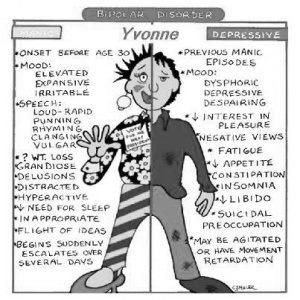Bipolar Disorder: Difference between revisions
No edit summary |
No edit summary |
||
| Line 28: | Line 28: | ||
== Medications == | == Medications == | ||
<span class="Apple-style-span" style="font-family: verdana, sans-serif; font-size: 12px; line-height: 15px; ">There are many medications that a physician may prescribe to a patient diagnosed with Bipolar disorder. One of the most popular medications that is prescribed is Lithium. It is a mood stabilizing drug and has been shown to significantly reduce the amount of hospitalizations in patients with Bipolar disorder. It has an effectiveness of up to 80% on all hypomanic and manic episodes. Valproate and Carbamazepine are the first and second most used anti-epileptic medications by many Bipolar disorder patients. These medications work well in treating symptoms such as mania, rapid-cycling and mixed states. Atypical antipsychotics, which are typically used to treat schizophrenia, have been proven to help in the treatment of Bipolar disorder. These include Clozapine, Olanzapine, Risperidone, Quetiapine, Aripiprazole and Ziprasidone. Since patients with Bipolar disorder typically have depression, they will at times be treated with anti-depressants. Although, anti-depressants have been shown to cause mania in 10-30% of patients. Anti-depressants typically prescribed for these patients are Bupropion, Fluoxetine, Citalopram, Sertraline and Proxetine</span><span class="Apple-style-span" style="font-family: verdana, sans-serif; font-size: 12px; line-height: 15px; ">.</span> | |||
== Diagnostic Tests/Lab Tests/Lab Values == | == Diagnostic Tests/Lab Tests/Lab Values == | ||
Revision as of 22:43, 17 March 2011
Original Editors - Michael Thompson from Bellarmine University's Pathophysiology of Complex Patient Problems project.
Lead Editors - Your name will be added here if you are a lead editor on this page. Read more.
Definition/Description[edit | edit source]
Bipolar disorder, also known as manic-depressive illness, is a disorder that deals with the human brain. The brain causes unusual shifts in mood, liveliness, activity levels, and the ability to carry out daily activities. People that suffer from this disease can experience mood swings that occur as few as a couples times throughout a year or up to multiple times within a day[1].
[Photo courtesy of Bipolar Disorder Symptoms. Available at http://cureanxiety.com/bipolar-disorder-symptoms.]
Prevalence
[edit | edit source]
The Depression and Bipolar Support Alliance has estimated that close to 6 million Americans are affected by bipolar disorder every year. Bipolar disorder can affect anyone at any age and is found in all races, ethnic groups and social classes with the typical onset being 25 years old. Patients may be diagnosed in their early childhood to as late as the 4th and 5th decades of life. Bipolar disorder is not gender based and can affect men and women equally. Although, studies have shown that women with Bipolar disorder have more depressive and mixed episodes than men with the disorder. More than 66% of people diagnosed with Bipolar disorder have at least one primary family member with the illness[2].
The incidence of Bipolar disorder in other countries is notable as well. In Australia it is approximately 238,957 people, in the United Kingdom it is approximately 723,248 people, in Germany it is approximately 989,095 people, in Canada it is approximately 390,094 people, in Iran it is approximately 810,038 people and for both India and China it is approximately 12-15 million people[3].
Characteristics/Clinical Presentation[edit | edit source]
add text here
Associated Co-morbidities[edit | edit source]
add text here
Medications[edit | edit source]
There are many medications that a physician may prescribe to a patient diagnosed with Bipolar disorder. One of the most popular medications that is prescribed is Lithium. It is a mood stabilizing drug and has been shown to significantly reduce the amount of hospitalizations in patients with Bipolar disorder. It has an effectiveness of up to 80% on all hypomanic and manic episodes. Valproate and Carbamazepine are the first and second most used anti-epileptic medications by many Bipolar disorder patients. These medications work well in treating symptoms such as mania, rapid-cycling and mixed states. Atypical antipsychotics, which are typically used to treat schizophrenia, have been proven to help in the treatment of Bipolar disorder. These include Clozapine, Olanzapine, Risperidone, Quetiapine, Aripiprazole and Ziprasidone. Since patients with Bipolar disorder typically have depression, they will at times be treated with anti-depressants. Although, anti-depressants have been shown to cause mania in 10-30% of patients. Anti-depressants typically prescribed for these patients are Bupropion, Fluoxetine, Citalopram, Sertraline and Proxetine.
Diagnostic Tests/Lab Tests/Lab Values[edit | edit source]
add text here
Etiology/Causes[edit | edit source]
add text here
Systemic Involvement[edit | edit source]
add text here
Medical Management (current best evidence)[edit | edit source]
add text here
Physical Therapy Management (current best evidence)[edit | edit source]
add text here
Alternative/Holistic Management (current best evidence)[edit | edit source]
add text here
Differential Diagnosis[edit | edit source]
add text here
Case Reports/ Case Studies[edit | edit source]
add links to case studies here (case studies should be added on new pages using the case study template)
Resources
[edit | edit source]
add appropriate resources here
Recent Related Research (from Pubmed)[edit | edit source]
see tutorial on Adding PubMed Feed
Extension:RSS -- Error: Not a valid URL: Feed goes here!!|charset=UTF-8|short|max=10
References[edit | edit source]
see adding references tutorial.
- ↑ National Institute of Mental Health. Health topics: bipolar disease. http://www.nimh.nih.gov/health/publications/bipolar-disorder/what-is-bipolar-disorder.shtml (accessed 16 March 2011).
- ↑ Depression and Bipolar Support Alliance. Bipolar disorder statistics. http://www.dbsalliance.org/site/PageServer?pagename=about_statistics_bipolar (accessed 17 March 2011).
- ↑ Bipolar-Lives. Bipolar disorder statistics. http://www.bipolar-lives.com/bipolar-disorder-statistics.html (accessed 17 March 2011).







